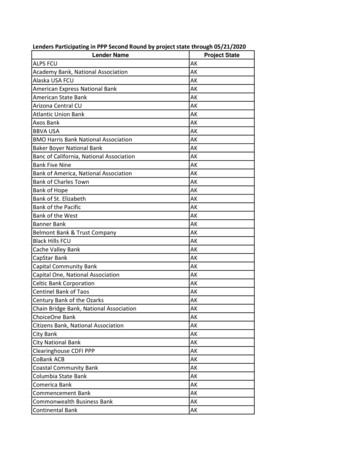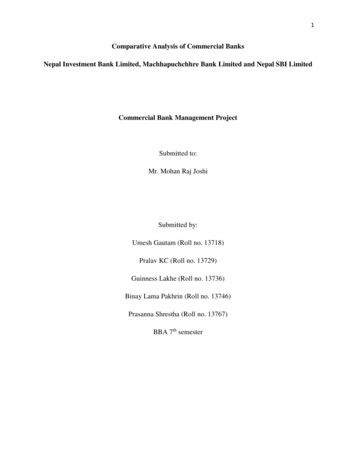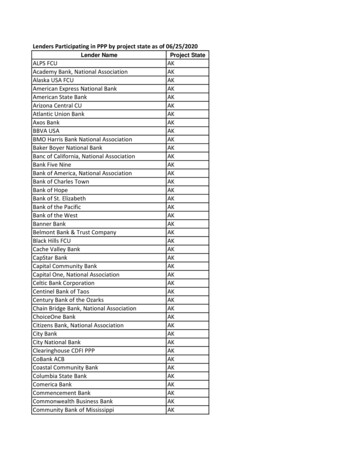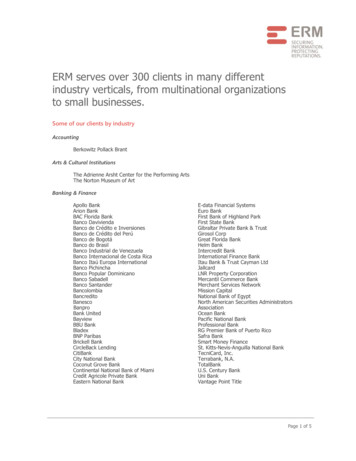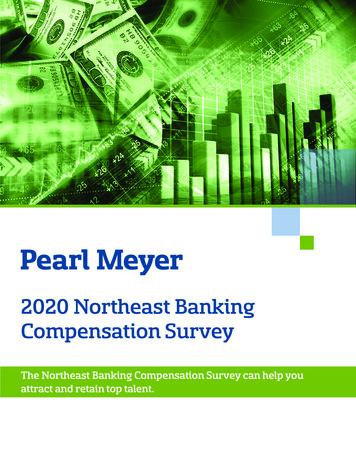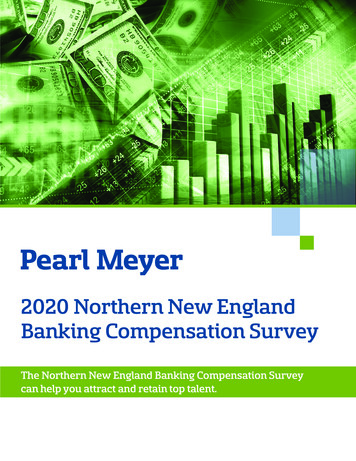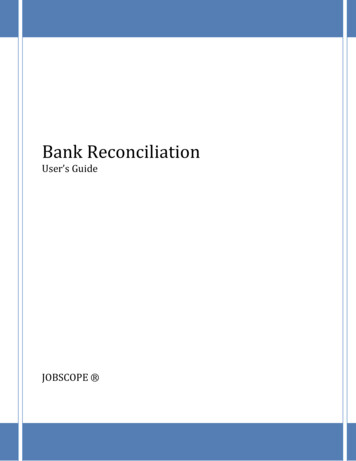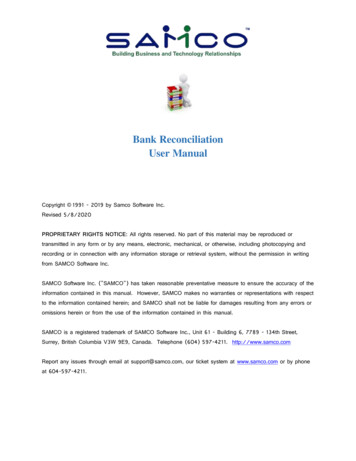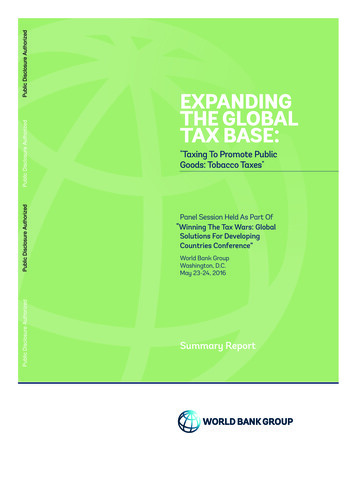
Transcription
Public Disclosure AuthorizedPublic Disclosure AuthorizedPublic Disclosure AuthorizedPublic Disclosure AuthorizedEXPANDINGTHE GLOBALTAX BASE:"Taxing To Promote PublicGoods: Tobacco Taxes"Panel Session Held As Part Of“Winning The Tax Wars: GlobalSolutions For DevelopingCountries Conference”World Bank GroupWashington, D.C.May 23-24, 2016Summary Report
2
SpeakersProf. George Akerlof2001 Nobel Prize Laureate in Economics, and University Professorat Georgetown UniversityProf. Philip CookITT/Terry Sanford Professor of Public Policy Studies, Duke UniversityJason FurmanChairman, President’s Council of Economic Advisers, Executive Office of thePresident of the United StatesJeremias Paulformer Under Secretary of Finance of the Philippines and now Coordinator,Tobacco Economics Program, WHORose ZhengEconomics and Tax Professor, School of International Trade and Economics(SITE), University of International Business and Economics (UIBE), Beijing,China, and Director of China’s WHO Tobacco Control Collaboration Center,Beijing, ChinaFernando SerraDirector of the Tax Advisory Unit, Ministry of Economy and Finance of UruguayModerator:Patricio V. MarquezLead Public Health Specialist, and Co-Coordinator, Global TobaccoControl Program, World Bank Group Health, Nutrition and Population (HNP)Global PracticeSession organized by:The World Bank Group Tobacco Control Program with the support ofBill & Melinda Gates Foundation and Bloomberg Foundation3
Expanding the Global Tax Base4
Taxing to Promote Public Goods: Tobacco TaxesExpanding the Global Tax Base:“Taxing To Promote Public Goods: Tobacco Taxes”Panel Session Held as Part of“Winning The Tax Wars: Global Solutions for DevelopingCountries Conference”World Bank GroupWashington, D.C.May 24, 2016Summary Report1Objective of the SessionThis panel session examined country experiences and discussed the resultsachieved from the application of tobacco taxation as a policy measureto reduce harmful behavior for health, and prevent ill health, prematuremortality and disabilities due to tobacco-related diseases while raising fiscalrevenues and reducing health care expenditures. Annex 1 includes theagenda of the session.Introduction to the Session(i) “Making the Public Health Case for Tobacco Taxation”Patricio V. Marquez (Lead Public Health Specialist, Health, Nutrition andPopulation (HNP) Global Practice, and Co Coordinator of the Global TobaccoControl Program, World Bank Group, and Moderator of the Session)Prepared by PatricioV. Marquez, Lead PublicHealth Specialist, Health,Nutrition and PopulationGlobal Practice, and CoCoordinator of the GlobalTobacco Control Program,World Bank Group, whoorganized and moderated thepanel session, as part of the“WINNING THE TAX WARS:GLOBAL SOLUTIONS FORDEVELOPING COUNTRIESCONFERENCE” organized byBlanca Moreno-Dodson, LeadEconomist, Global TaxationTeam, Governance GlobalPractice, World Bank Group.1The scientific evidence accumulated over the last five decades is clear andirrefutable: tobacco use kills. Tobacco taxation, along with measures to reducethe social acceptability of smoking, is one of the most cost effective publichealth measures to prevent people, particularly the youth, from becomingaddicted to a product that causes ill health, premature mortality and disability,as well as high direct and indirect costs for families, communities, and societyat large.Tobacco use, and its negative health, social and economic impact, is a globalproblem. It is estimated that 1.1 billion people smoke globally. According tothe 2015 World Health Organization (WHO) Report on the Global TobaccoEpidemic, in 2013, 21% of adults globally were current smokers – 950 millionmen and 177 million women.5
Expanding the Global Tax BaseTobacco use is a leading global disease risk factor and underlying cause ofill health, preventable death, and disability. It is estimated to kill more than 5million people each year across the globe. If current trends persist, tobacco willkill more than 8 million people worldwide each year by 2030, with 80% of thesepremature deaths taking place in the developing world.The 2015 World Health Organization (WHO) report on tobacco taxation raises atroubling question for policymakers across the world: If, as shown by scientificevidence, tobacco is a leading global disease risk factor, why then are so fewgovernments levying appropriate levels of tax on cigarettes and other tobaccoproducts to raise prices and reduce consumption?The importance of this question is accentuated by the widely accepted fact thatraising taxes on tobacco products is one of the most cost-effective measures toreduce consumption of products that kill. Besides the potential health benefitsof tobacco taxation, this policy measure could help broaden the tax base ofcountries and generate additional revenue to support budgetary capacity tofinance priority investments and programs that benefit the entire population.Indeed, as recognized in the “Financing for Development Action Agenda”that was approved by the Heads of State and Government and High LevelRepresentatives of countries in Addis Ababa, Ethiopia in mid-July 2015 at theThird International Conference on Financing for Development, and endorsed inSeptember 2015 at the United Nations General Assembly (UNGA) as part of theSustainable Development Goals (SDG) to be achieved by 2030, price and taxmeasures on tobacco can be not only effective and important means to reducetobacco consumption and health care costs, but represent a revenue stream forfinancing for development in many countries.Findings in the WHO report show that while only 33 countries impose taxes thatconstitute more than 75% of the retail price of a pack of cigarettes—the taxationlevel recommended to have an impact on consumption —most countries thatdo tax tobacco products have extremely low tax rates. And some countries donot have a special tax on tobacco products at all.Given this situation, what can be done to make the case and encouragegovernments to look at accumulated evidence worldwide, and not simply thetobacco industry’s arguments, and to use tax policies to increase the retail priceof tobacco products as one of the best available public health policy measures?If we do not want to be passive spectators to the unhindered growth of thisthreat to global health, then political will at the highest levels of governmentneeds to be galvanized, coupled with sustained support from civil society andinternational organizations. This is required not only to shine a light upon thisdeadly but entirely preventable health risk, but more importantly, to promoteeffective and sustained action to deal with it.6
Taxing to Promote Public Goods: Tobacco TaxesThe World Bank Group’s Global Tobacco Control Program supportsgovernments to look at accumulated country evidence and use taxmeasures to increase the retail price of tobacco products as one of the bestavailable public health policy measures.Some important lessons from international experience about how toeffectively implement tobacco tax policy to achieve public health objectivescan be adopted and adapted in policy dialogue and operational support tocountries. Such lessons include (World Bank, 1999; Sunley, 2009; WHO GlobalTobacco Report 2015; IMF 2016): While nearly all countries tax tobacco products, an excise tax is the mostimportant type of tobacco tax, since it applies uniquely to tobaccoproducts and raises prices relative to those of other goods and services. Simpler tobacco tax structures are more effective than complex (tiered)ones which are difficult to administer and can undermine the healthand revenue impacts of tobacco excise taxes. Use of specific and uniform excise taxes enhances the impact of tobaccotaxation on public health by reducing price gaps between premium andlower-priced alternatives, which limits opportunities for users to switchto less-expensive brands in response to tax increases. Taxing all tobaccoproducts comparably reduces incentives for substitution. Ad valorem taxes are difficult to implement and weaken tax policyimpact. Since they are levied as a percentage of price, companies havegreater opportunities to avoid higher taxes and preserve or grow thesize of their market by manufacturing and selling lower-priced brands.This also makes government tax revenues more dependent on industrypricing strategies and increases the uncertainty of the tobacco taxrevenue stream. Specific excise taxes need to be adjusted for inflation to remain effective,and tax increases should reduce the affordability of tobacco products.In many countries, where incomes and purchasing power are growingrapidly, large price increases are required to offset growth in realincomes. Strong tax administration is critical to minimize tax avoidance and taxevasion, to ensure that tobacco tax increases lead to higher tobaccoproduct prices and tax revenues, as well as reductions in tobacco useand its negative health consequences.7
Expanding the Global Tax Base Regional agreements on tobacco taxation can be effective in reducingcross-border tax and price differentials and in minimizing opportunitiesfor individual tax avoidance and larger scale illicit trade.Panel Presentations and DiscussionThe first part of the session included two presentations that provided an overallframework for understanding the nature and characteristics of tobacco use andits negative social impact. The second part of the session focused on countryexperiences on the adoption of tobacco tax policy measures, the resultsgenerated, and lessons learned.A Framework for Discussion(ii) “Phishing for Phools: “The Economics of Manipulationand Deception”George Akerlof (2001 Nobel Prize Laureate in Economics and UniversityProfessor at Georgetown University)The challenge posed by tobacco use globally becomes clear byunderstanding insights from the economics of manipulation and deception.Prof. Akerlof explained that ever since Adam Smith, the central teachingin economics has been that free markets provides us with material wellbeing, as if by an invisible hand. But this fundamental insight in economicsis challenged by the fact that markets harm as well as help us. As long asthere is profit to be made, sellers will systematically exploit our psychologicalweaknesses and our ignorance through manipulation and deception. Thatis, rather than being essentially benign and always creating the greater good,markets are inherently filled with trick and traps and will “phish” us as “phools.”In regards to human behavior, the job of psychologists is to ferret out ourpsychological weaknesses or susceptibilities. In a free market equilibrium, ifwe have some weaknesses, they will be exploited as long as there is a profitto be made. In free competitive markets, we are free to choose, but also “freeto phish.”8
Taxing to Promote Public Goods: Tobacco TaxesThe four “we-could-not possibly-wants” are personal financial insecurity,financial/macroeconomic instability, ill health, and bad government. Insignificant ways, sellers play to our weaknesses. They are “phishing for phools.”“Humans think in terms of stories, and decisions are consequently determinedby the stories we tell ourselves. Advertisers use this to their advantage by“graph[ing] their story” onto ours, and thereby influencing the decisions wemake—in this case, to get us addicted to tobacco use, particularly teenagersand low-income people.”This insight could also be used to promote tobacco control. An exampleof this is the 1964 United States Surgeon General’s Report. The story toldwas that “smoking is stupid.” This led to free airtime and bans on indoorsmoking in the United States. The arsenal of effective consumer protectionregulations that have contributed to reduce the social acceptability ofsmoking also includes advertising bans, smoke-free public spaces, andrestricting sales to minors. In the United States as mandated to the U.S Foodand Drug Administration (FDA) by the 2009, “Family Smoking Preventionand Tobacco Control Act,” regulatory agencies have authority to regulatethe manufacture, distribution, and marketing of tobacco products, includinge-cigarettes, like any other drug.Another recent example is Australia’s 2012 legislation that was adopted toreduce the appeal of smoking by restricting the use of logos, colors, brandimages, or promotional information on packaging other than brand namesand product names displayed in a standard color and small font below hardhitting warnings depicting the negative health consequences of smoking.In the two years following the law, tobacco consumption declined 12.8%,which some have attributed, in part, to the legislation.Other countries are starting to follow Australia’s example. Similarregulations approved in France and the United Kingdom are set to beginimplementation in 2016, and they are under formal consideration in severalother countries across the world. Uruguay and Thailand already mandatethat at least 80% of front and back of the packaging be covered with graphichealth warnings. And Mauritius leads Africa in terms of requirements fortobacco packaging and labelling.Cigarette taxes also play an important role in tobacco control. Taxingtobacco leads to better health, increased revenues, reduction in health costs,and protection of the lives of loved ones. And, “the role of stories in all of thisis that they legitimate the higher taxes and make them collectible, and aswell as promote political and social acceptance of other regulatory measuresto control tobacco use.”9
Expanding the Global Tax Base(iii) “Paying the Tab” The Costs and Benefits of Tobacco andAlcohol Control”Philip Cook (Professor of Public Policy and Economics at Duke Universityand former Director of Duke University’s Sanford Institute of Public Policy)High excise taxes on tobacco and alcoholic beverages are not an attractivesource of revenue unless they are effective in reducing use and abuse.Why? Such taxes could be regressive by the usual standard, and the highprices that result could constitute a particular burden on the poor and oftendisabled heavy users.2That would be a dubious proposition if usage were completely insensitiveto prices. Hence, high taxes must be justified by evidence that “they areeffective in reducing abuse and improving the public health.”Making that case persuasively is not easy. In the past, most experts onsmoking and alcohol abuse did not believe that prices mattered, nor did thepublic. For alcohol abuse, for example, the dominant school of thought wasthat the main problem was alcoholism, and that alcoholism was an addictioncharacterized by loss of control. It stood to reason that addicts would find away to drink their fill even if prices went up. A tax amounting to, say, an extradime a drink, was not going to make any difference to people who werealready suffering great personal losses for the sake of sustaining their habit.The primary effect of a high tax would be to make their difficult lives evenmore so.This argument has intuitive appeal but is incorrect in important ways. First,the problem of alcohol abuse is not synonymous with alcoholism. Youthsand other non-alcoholic drinkers who get drunk occasionally can do a lot ofdamage, as reflected in statistics on highway safety, injuries, violent crime,domestic violence, and even death by alcohol poisoning or ethylic coma.Of course, it could be arguedthat it is simply “fair” forthe smoker or drinker tocompensate the public fornegative externalities of theiruse. But “fairness” in thatregard assumes that the badhabits are a choice, freelymade.210Second, even if the direct effect of prices are on the consumption habits ofrelatively moderate drinkers, heavy drinkers can be affected indirectly. There isgood evidence that drinking occurs in a social context, and that drinkers acrossthe spectrum influence each other. So if alcohol prices can affect the drinkingpatterns at the median, then the upper tail of the distribution will shift inward.That is to say, there will be a reduced prevalence of heavy drinking.There is no need to just speculate on these matters – the so-called“laboratory of the states” in the United States, for example, provides strongevidence. That is, over the past 20 years, there has been scores of cases in
Taxing to Promote Public Goods: Tobacco Taxeswhich states increased their alcohol excise taxes. Those cases could be seenas trials in a sort of natural experiment, with states that did not change theirtax as the control group. The assessments done utilized administrative dataon alcohol sales and health-related outcomes, so not to rely on survey data-- which are always suspect when it comes to drinking and smoking.The assessments found that an increase in the state tax consistently resultedin a reduction in tax-paid sales per capita. That was a first step, but notenough, because skeptics could say that some drinkers were avoiding thehigher tax by buying their booze in neighboring states. It is also possiblethat only the moderate drinkers were cutting back, so that the reduction hadlittle effect on the amount of alcohol-related harm.So, in addition to analyzing sales data, the assessment also analyzed theeffect on the cirrhosis mortality rate. Cirrhosis mortality is a good indicatorof the prevalence of long-term heavy drinking, and in particular alcoholism.What was found was the same pattern as for sales -- cirrhosis mortalitydropped when taxes went up. In other words, higher prices postponed orprevented their deaths due to liver disease. That was direct evidence thatthe tax reduced the consumption of heavy drinkers and a clear indicationthat the tax was effective with one of the target populations.In the 35 years since the initial period of study, there have been numerousstudies of the effects of alcohol tax changes, for a variety of outcomes –injury mortality, violent crime, STDs, suicide, domestic violence, and so forth.The results are consistently positive. One of the recent studies found thatwhen the United States Congress doubled the federal beer tax in 1991, theresult in just the first year was to save 7,000 lives.These days, most experts are on board with the idea that higher alcoholtaxes tend to reduce alcohol abuse and dependence, and the costlyconsequences thereof. But that conclusion remains a tough sell with thepublic and the politicians, especially given the alcohol industry’s lobbyingand disinformation campaign. And since 1991 the United States Congressand most of the states have little to legislate in this area, letting inflationgradually erode the value of alcohol excises. In fact, inflation has in effectrepealed the 1991 legislation that doubled the federal beer tax.Tobacco taxes have been a very different story in the United States in recentyears. The politics changed in 1998 with the Tobacco Master SettlementAgreement (MSA), originally between the four largest United States tobaccocompanies (Philip Morris Inc., R. J. Reynolds, Brown & Williamson and Lorillard– the "original participating manufacturers", referred to as the "Majors") andthe attorneys general of 46 states, which settled the states’ Medicaid lawsuits11
Expanding the Global Tax Baseagainst the tobacco industry for recovery of their tobacco-related health-carecosts. Large increases in federal and state tax rates have generated manybillions in extra revenues despite the resulting decline in smoking. It is widelyacknowledged that much of that decline has been induced by the increasedpost-tax tobacco prices.Interestingly, some of the best evidence that higher taxes are effective incurtailing tobacco use is similar to the evidence for alcohol abuse-- it comesfrom the “laboratory of the states” in the United States, and in particularanalysis of data generated by many instances in which state legislatureschanged tobacco taxes. While there is no doubt that nicotine addictionplays a powerful role in smoking cigarettes, higher prices appear helpful indiscouraging initiation and encouraging cessation.Alcohol and tobacco differ in one important respect, namely the publichealth goal. For tobacco, the best answer is abstention -- there is no safelevel of smoking. But for drinking, it is moderation, where some scientistsactually believe, as many people do, that a drink or two a day is good for thehealth. As a result, one objection to the alcohol excise tax is that even if it isan effective public health measure, it is poorly focused, in effect punishing alldrinkers regardless of whether their drinking is problematic.But in fact, the alcohol tax is surprisingly well focused on negative externalitiesof drinking. Consider a proposed increase of 10 cents per drink, which wouldamount to an annual payment of US 60/capita on average. But, that average,conceals a huge range. One-third of adults in the United States abstain, andthey would obviously pay nothing if the tax were increased. Most drinkers donot drink much, and for them the tax would be just a few extra dollars per year.The bulk of the extra revenue would come from the top 15% of the drinkers(who average 8 or 9 drinks per day); they consume 75% of all the alcohol andhence would pay 75% of new tax. That is also the group that accounts for mostof the alcohol-related damage. Hence the claim that it is well targeted.If the extra revenue were returned directly to the public as a sort of uniformdividend, most adults would receive more than they paid in. And most everyonewould benefit from reduced drinking and abuse, starting with the financialbenefit of reduced insurance rates, and a reduced threat of violent crime.In conclusion, the case for higher excise taxes begins with the evidence thatthey are effective in controlling excess use. While experts are now in agreementthat alcohol and tobacco excises are powerful public health instruments, weare a long way from persuading the public of that truth, especially for alcohol.While we all know much of the context on the rationale for taxing tobacco andalcohol, we also know that the key to change is action at a country level.12
Taxing to Promote Public Goods: Tobacco TaxesCountry Experiences(iv) “Six lessons from the U.S. Experience with Tobacco Taxes”Jason Furman (Chairman of the United States President’s Council ofEconomic Advisers)When people think about what the Obama Administration did to improvepublic health, they often think immediately of the Affordable Care Act (ACA),and appropriately so. The ACA is undoubtedly the single most importanthealth-related legislation of not just the Obama Administration, but of recentdecades. But this Administration has also taken many other steps that areimproving Americans’ health. The legislation that President Obama signed inhis first month in office in 2009, which raised the Federal cigarette tax from 0.39 per pack to approximately 1.01 per pack, was his most importantpublic health legislation.Plausible estimates suggest that this increase in cigarette taxes will reducethe number of premature deaths due to smoking by between 15,000 and70,000 for two young population cohorts (12-17 and 18-25). The healthbenefits will be progressively distributed, representing a far larger fractionof income for lower-income families, and even more so when counting thebenefits of the expansion of children’s health insurance coverage that theincrease funded as discussed below.It is important to understand that these tax measures complement a range ofother steps to reduce the threat to public health posed by tobacco products.In 2009, President Obama signed legislation providing the Food and DrugAdministration (FDA) with authority to regulate tobacco products, andrequiring FDA approval of certain new tobacco products, building on a seriesof steps that began with the U.S. Surgeon General’s 1964 report on the harmsof tobacco.The ACA requires health insurance to cover tobacco counseling andinterventions without cost sharing, and requires that Medicaid programscover cessation services for pregnant women. With funding from theACA’s Prevention Fund, the United States Centers for Disease Controland Prevention (CDC) launched an aggressive, graphic media campaignhighlighting the health and physical impacts of smoking called Tips fromFormer Smokers. The FDA finalized in May 2016 a rule extending its regulatoryauthority to all tobacco products, including e-cigarettes, cigars, hookahtobacco, and pipe tobacco.13
Expanding the Global Tax BaseExternalities, Internalities and Addictive GoodsBefore diving into the estimates, it is useful to briefly discuss the underlyingtheory and motivation, because it affects not only the assessment of pastpolicies but also the analysis and motivation for future ones. Tobaccoimposes a number of costs on society that can be understood through thetraditional economic concept of “externalities,” including the negative healthand amenity effects of second hand smoke, the large costs to children andsociety more broadly of low birthweight babies that happen when a mothersmokes during pregnancy, and the additional health costs borne by all of usto help care for smokers.But smoking has its largest effects on smokers themselves, imposing acost of about US 25 to US 50 or more on someone in terms of shorter lifeexpectancy and other negative health effects. A “rational” person should havean additional pack of cigarettes if the benefit to him or her exceeds at least 25 plus the relatively modest cost of producing the pack of cigarettes itself.In most cases it could be assumed that government policy should addressexternalities, but that rational consumers would fully take into account allof the internal costs and come to the optimal decision with no further needfor public policy intervention. However, in the case of tobacco use, there area number of reasons to believe this simplistic analysis is incorrect. First, andperhaps most importantly, is what economists call the present-bias problem.Across a wide range of domains, we have evidence that people overweightthe present at the expense of the future. In the case of tobacco use, whichhas large costs that appear many years in the future, this leads to smoking atrates above the socially optimal.The highly addictive nature of tobacco greatly exacerbates this problemsince, once people have started smoking, it is difficult to stop even if theydecide they want to. Evidence suggests that overly optimistic assessments ofone’s ability to quit also play a role in smoking initiation. In surveys, far moreteenagers who smoke report that they will quit than those who ultimatelydo. Teenagers may excessively discount the future health costs assumingthat they will be able to quit smoking when, in reality, quitting is much moredifficult than they think.When individuals do not take into account costs they impose on themselvesfor whatever reason, economists refer to it as an “internality.” Finally, althoughwe have made major strides in increasing public awareness of the health risksof smoking, traditional informational shortcomings may also play a role insmoking initiation.14
Taxing to Promote Public Goods: Tobacco TaxesLesson #1: Smoking Plays a Major Role Not Just inMortality but in the Inequality of MortalityThere is substantial concern in the United States and around the world aboutgrowing inequality. Recently a number of scholars have advanced the starkand troubling thesis that the United States is witnessing a dramatic increasenot just in income inequality but also in life expectancy inequality (Chetty etal. 2016, National Academies 2015). The truth is a little more complicated thanthat, however, and smoking plays an important role in the story.First, the broader public health story. Age-adjusted death rates in the UnitedStates have fallen sharply since the 1950s, with particularly notable declinesin death rates from heart disease and stroke, among others, as shown inFigure 1 (CDC 2016). Decreasing death rates have led to a substantial increasein period life expectancies at birth, from 68.2 years in 1950 to 78.8 yearsin 2013. But while as all-cause death rates were falling rapidly, death ratesfor lung cancer were rising rapidly, tripling from 1950 to 1990. Since 1990,however, death rates for lung cancer have dropped by nearly one-third.This result partly reflects the success of the sustained campaign to combatsmoking waged in the United States over the last half century, a phenomenalpublic health achievement.The data on mortality inequality tells a more nuanced tale. Troublingly, forthose who have reached middle-age, the gap in life expectancy betweenhigher income individuals and lower income individuals has grownsubstantially. At the same time, mortality rates early in life are actually fallingmore quickly in low-income areas than in high-income areas (Currie andSchwandt 2016).Figure 1: Percent that Ever Smoked by poverty Status,United States, 1991-2014Age 50 PercentAges 18-4070Above Poverty Line60Below Poverty Line50Below Poverty Line40Above Poverty 2014Source: NHIS and CEA calculations following Currie and Schwandt (2016).15
Expanding the Global Tax BaseDiffering trends in smoking rates by income are likely one important factordriving differences in the evolution of mortality rates for the young and old.The share of the population 50 and older “below” the poverty line that hasever smoked has grown over the last twenty-five years while the share ofthe population 50 and older “above” the poverty line that has ever smokedhas decreased. In contrast, smoking rates for the population ages 18-40 havedeclined substantially regardless of poverty status, and smoking rates for peopleliving in poverty are only slightly higher than for those not living in poverty.Lesson #2: Price Plays an Important Role in SmokingFrom 1954 to 1983, inflation-adjusted cigarette prices were essentially flat,coinciding with an increase in per capita cigarette co
(ii) “Phishing for Phools: “The Economics of Manipulation and Deception” George Akerlof (2001 Nobel Prize Laureate in Economics and University Professor at Georgetown University) The challenge posed by tobacco use globally becomes clear by understanding i


